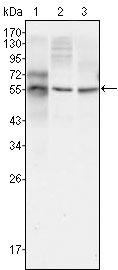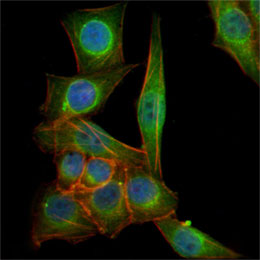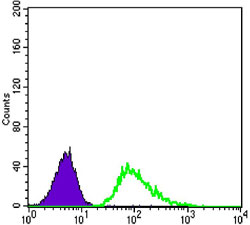TUBB3 Antibody
Purified Mouse Monoclonal Antibody
- 产品详情
- 实验流程
Application
| WB, FC, ICC, E |
|---|---|
| Primary Accession | Q13509 |
| Reactivity | Human |
| Host | Mouse |
| Clonality | Monoclonal |
| Clone Names | 2E9 |
| Isotype | IgG1 |
| Calculated MW | 50433 Da |
| Description | Tubulin, beta 3, also known as TUBB3. Tubulin is the major constituent of microtubules. It binds two moles of GTP, one at an exchangeable site on the beta chain and one at a non exchangeable site on the alpha-chain. Tubulin is a highly conserved protein with a molecular weight of ~50 kD. Microtubules play key roles in chromosome segregation in mitosis, intracellular transport, ciliary and flagellar bending, and structural support of the cytoskeleton. The two main tubulin isoforms, α- and β-tubulin, are usually products of separate genes. The β-tubulin family includes six expressed genes that produce the polypeptide isoforms known as Classes I through VI, each of which have a distinct pattern of expression. Class III β-tubulin is found in neurons and mammalian testis cells and is widely used as a neuronal marker in developmental neurobiology, neoplasia, and stem cell research. Class III β-tubulin expression in neuronal and neuroblastic tumors is differentiation dependent, and its expression in certain non-neuronal neoplasms has been associated with poor prognosis and/or resistance to chemotherapy. |
| Immunogen | Purified recombinant fragment of human TUBB3 expressed in E. Coli. |
| Formulation | Ascitic fluid containing 0.03% sodium azide. |
| Gene ID | 10381 |
|---|---|
| Other Names | Tubulin beta-3 chain, Tubulin beta-4 chain, Tubulin beta-III, TUBB3, TUBB4 |
| Dilution | WB~~1/500 - 1/2000 FC~~1/200 - 1/400 ICC~~N/A E~~N/A |
| Storage | Maintain refrigerated at 2-8°C for up to 6 months. For long term storage store at -20°C in small aliquots to prevent freeze-thaw cycles. |
| Precautions | TUBB3 Antibody is for research use only and not for use in diagnostic or therapeutic procedures. |
| Name | TUBB3 |
|---|---|
| Synonyms | TUBB4 |
| Function | Tubulin is the major constituent of microtubules, protein filaments consisting of alpha- and beta-tubulin heterodimers (PubMed:34996871, PubMed:38305685, PubMed:38609661). Microtubules grow by the addition of GTP-tubulin dimers to the microtubule end, where a stabilizing cap forms (PubMed:34996871, PubMed:38305685, PubMed:38609661). Below the cap, alpha-beta tubulin heterodimers are in GDP-bound state, owing to GTPase activity of alpha-tubulin (PubMed:34996871, PubMed:38609661). TUBB3 plays a critical role in proper axon guidance and maintenance (PubMed:20074521). Binding of NTN1/Netrin-1 to its receptor UNC5C might cause dissociation of UNC5C from polymerized TUBB3 in microtubules and thereby lead to increased microtubule dynamics and axon repulsion (PubMed:28483977). Plays a role in dorsal root ganglion axon projection towards the spinal cord (PubMed:28483977). |
| Cellular Location | Cytoplasm, cytoskeleton. Cell projection, growth cone {ECO:0000250|UniProtKB:Q9ERD7}. Cell projection, lamellipodium {ECO:0000250|UniProtKB:Q9ERD7}. Cell projection, filopodium {ECO:0000250|UniProtKB:Q9ERD7} |
| Tissue Location | Expression is primarily restricted to central and peripheral nervous system. Greatly increased expression in most cancerous tissues. |
Research Areas
For Research Use Only. Not For Use In Diagnostic Procedures.
Application Protocols
Provided below are standard protocols that you may find useful for product applications.
REFERENCES
1. Histopathology. 2007 Jun;50(7):949-52. 2. Neurochem Res. 2007 Aug;32(8):1387-98. 3. Exp Eye Res. 1995 Apr;60(4):385-400.
终于等到您。ABCEPTA(百远生物)抗体产品。
点击下方“我要评价 ”按钮提交您的反馈信息,您的反馈和评价是我们最宝贵的财富之一,
我们将在1-3个工作日内处理您的反馈信息。
如有疑问,联系:0512-88856768 tech-china@abcepta.com.
¥ 1,500.00
Cat# AO1310a























 癌症的基本特征包括细胞增殖、血管生成、迁移、凋亡逃避机制和细胞永生等。找到癌症发生过程中这些通路的关键标记物和对应的抗体用于检测至关重要。
癌症的基本特征包括细胞增殖、血管生成、迁移、凋亡逃避机制和细胞永生等。找到癌症发生过程中这些通路的关键标记物和对应的抗体用于检测至关重要。 为您推荐一个泛素化位点预测神器——泛素化分析工具,可以为您的蛋白的泛素化位点作出预测和评分。
为您推荐一个泛素化位点预测神器——泛素化分析工具,可以为您的蛋白的泛素化位点作出预测和评分。 细胞自噬受体图形绘图工具为你的蛋白的细胞受体结合位点作出预测和评分,识别结合到自噬通路中的蛋白是非常重要的,便于让我们理解自噬在正常生理、病理过程中的作用,如发育、细胞分化、神经退化性疾病、压力条件下、感染和癌症。
细胞自噬受体图形绘图工具为你的蛋白的细胞受体结合位点作出预测和评分,识别结合到自噬通路中的蛋白是非常重要的,便于让我们理解自噬在正常生理、病理过程中的作用,如发育、细胞分化、神经退化性疾病、压力条件下、感染和癌症。








